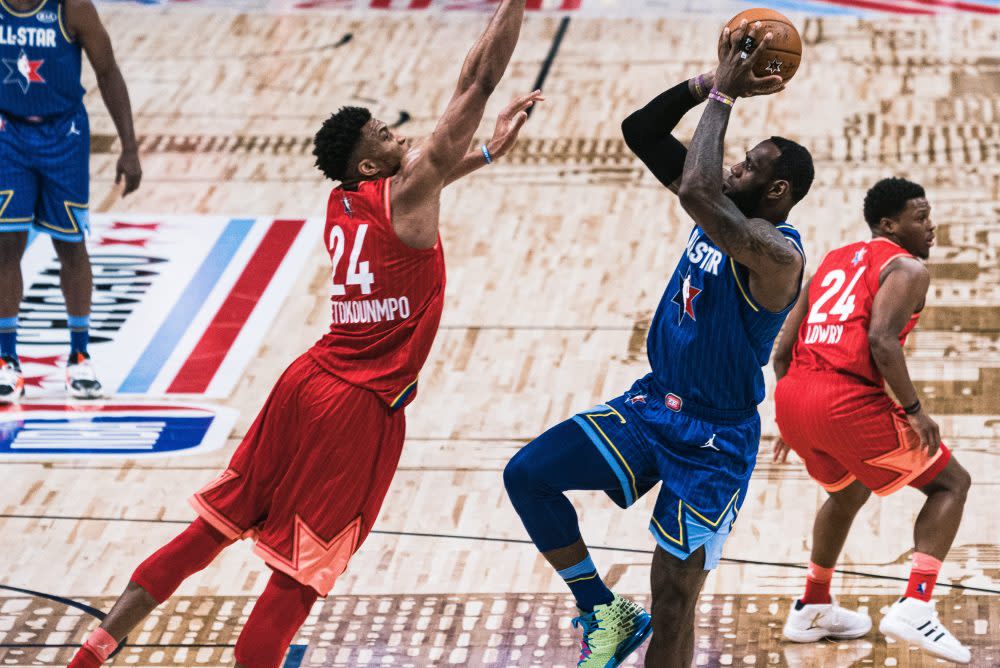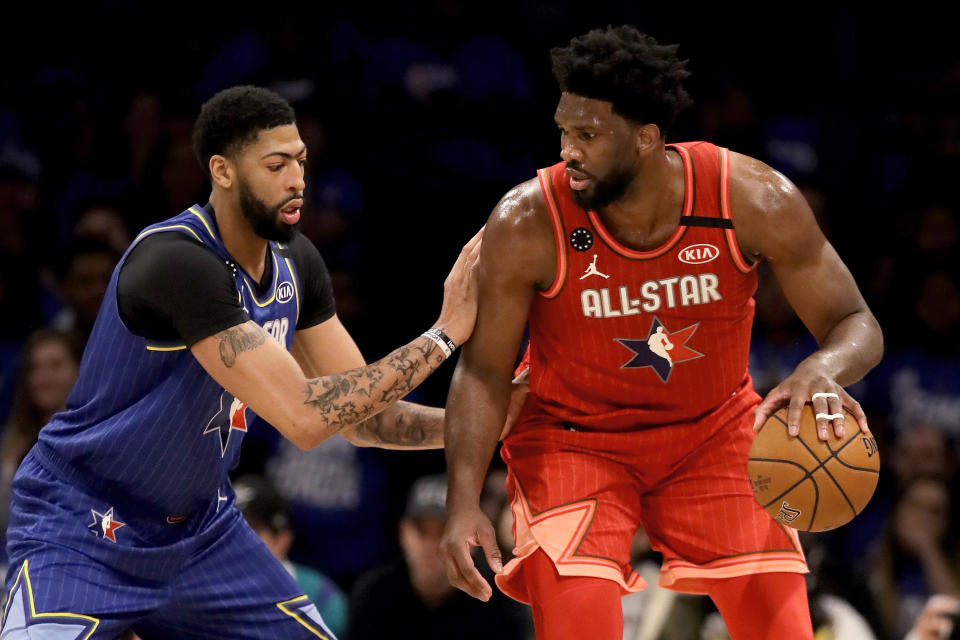The NBA’s Best Players Love the All-Star Game’s “Elam Ending.” Could It Ever Stick?

Nick Elam had waited 14 years to hear from the NBA.
Since his college days watching the NCAA tournament, he’d thought about an alternative scoring system for the end of basketball games, which he noticed often lost their flow and fell victim to too much fouling in the final minutes. To fix the issue, the Ball State professor and Mensa member would craft a new format for the fourth quarter, eliminating the game clock following the first dead ball under four minutes and establishing a target score that both teams would race to achieve. Though he’d spent more than a decade collecting data, sending proposals and successfully implementing the format into The Basketball Tournament (an upstart summer tournament with a $2 million prize that now airs on ESPN), he couldn’t get in touch with anyone at the sport’s highest level.
“A lot of that was one-way communication, or I just left my research and concepts at the doorstep,” Elam tells InsideHook. “But I just kept at it.”
That determination paid off on January 20, 2020, when an NBA league official called to inform Elam that, after positive support from the players, a tweaked version of his “Elam Ending” would be implemented into the next month’s All-Star Game. The event would amend his concept, feature an entirely untimed fourth quarter, and establish a target score 24 points (in honor of Kobe Bryant’s passing) higher than the leading team’s total after three frames. A few weeks later in Chicago, Elam would become responsible for turning an exhibition distinguished by its lack of intensity and urgency into a thrilling wire-to-wire contest.
Throughout the All-Star Game’s fourth quarter, Team LeBron and Team Giannis sprinted the length of the court with an effort and conviction that implied more was at stake than temporal glory. Players took charges, argued calls and crashed hard to the rim while a boisterous crowd stayed on its feet for the final frame’s entirety, supplying a playoff atmosphere. When Anthony Davis’s game-ending free throw sealed a 157-155 victory for his Laker teammate’s hand-picked squad, it capped a celebratory night for the NBA. “It was amazing,” Elam remembers. “I had high expectations for it, but even that exceeded my expectations.”
In response to the excitement between players and fans on social media from that night, the NBA has decided to bring the “Elam Ending” back to this weekend’s All-Star Game, hoping to recapture last year’s energy, albeit under different circumstances. The decision was a testament to Elam’s vision and a subtle reminder that basketball remains its best when it evolves. “It made sense to continue utilizing the new format,” Evan Wasch, senior VP and Head of NBA Basketball Strategy & Analytics, says over email. “We saw increases in viewership and overall fan engagement, and the qualitative feedback we heard from players, coaches, media and fans was overwhelmingly positive.”
The format’s return may create a new hardwood tradition, but its integration is also an important lesson in patience and persistence. After all, Elam, a lifelong basketball fan, officially started this mission in 2007, when it was just a “self-contained exploration” into the way basketball games could end with more drama and better pace. “Convincing myself, that was one hurdle,” Elam says. “But then, obviously, the really tough part was trying to convince someone else in the basketball world that it had merit.”
Over the next decade, in between his jobs as an Ohio middle school principal and a Cincinnati Reds groundskeeper, Elam spent his free time collecting data and investing money into his new hobby. At first, he took yearly notes of the NCAA Tournament and spoke at various sports conferences about his findings, cramming them into 200-page proposals he’d send through the mail to various basketball experts and officials. Eventually, he opened up his data sets to include nationally televised NBA matchups and ESPNU contests that he recorded on TV each night, ultimately logging more than 2,900 games between 2014 and 2018. “Spreadsheets have come in handy,” Elam laughs. “I truly have watched the last stretch of all these games because a lot of the things that I’m trying to look for are not available in the box score.”
By 2016, the robust compilation Elam was building gave him the confidence to try another round of proposals. This time, he reached out to The Basketball Tournament (TBT) and sent a 67-page PowerPoint blindly to its general information email account.
“It was an extremely well-written email and cover letter,” remembers TBT CEO Jon Mugar, who considers himself a basketball purist. “I was sort of looking immediately for a reason to dismiss the email [but] it was perfectly worded and perfectly punctuated and he laid out the problem extremely well.” After six months of consideration, Mugar opted for a trial run of what Elam called a “hybrid duration format” for his 2017 play-in games and tournament.
From the opening round in ’17, Elam knew his ending would be there to stay. He watched teams leading with under four minutes play assertively to the finish line, while the trailing teams (which conceded around 70% of their games) finally had a chance to control their own fate, rather than being at the mercy of the clock. “I had played out these scenarios countless times in my mind and on paper and, here I was, after 10 years, finally seeing it play out in real life,” he says. “That was really exciting.”
He and Mugar began by adding seven points to the leading team’s score (they adjusted later to eight), and soon witnessed fans standing up and engaging once the game clock was shut off. “For 10 years I’d been speaking on behalf of the concept,” Elam says. “And now, finally, the concept was getting a chance to speak for itself.”

The format has stayed in place at TBT ever since, producing finishes akin to those with clock-induced drama. Elam even remembers one game in which Josh Selby, a former NBA draft pick, hit a game-winning mid-range jump shot and celebrated by ripping off his jersey, a moment he was glad his ending could still produce. “It had the look and sound and feel of a buzzer-beater,” he says.
The hype for the format only mounted with similar highlights, and soon players such as Chris Paul were advocating the league to adopt it. “If you’d told me when we got that email that it would be in the NBA All-Star Game in three years, I would have punched you in the face,” Mugar says. “To give it that platform only three years after it came to us, it was beyond my wildest dreams.”
In many ways, TBT was a perfect test-kit for the “Elam Ending.” Mugar admits that although he didn’t plan on making drastic changes to the game’s regulations, he was always interested in experimenting with formats to improve his high-stakes tournament. “I’ve sat through 160 of these now and every single time there’s this enormous upsurge in emotion,” Mugar says. “When we have a packed arena, it’s incredible because this is the only thing I’ve ever seen to [make people] put their cell phones away.”
But implementing the format beyond tournaments and exhibitions like the All-Star Game is trickier. Detractors have argued against it, claiming it takes away true buzzer-beaters and that it might change how we understand a player’s or team’s statistics at the end of games. Elam mostly dismisses those fears, arguing the rules today allow for more score warping in the final minutes (a player can inflate his box score with numerous free throws) and that his format provides a more authentic, natural flow to point-scoring. “I think basketball has gone in a direction statistically that already accounts for this,” Elam says. “Historians of the game have shifted away from per-game totals, or per-minute totals … and they focus much more on per-possession points.”
Ultimately, though, the format’s success relies on the players themselves. Without a clock dictating an inevitable outcome, trailing teams can still make improbable comebacks, but only if they force opponents to keep playing hard no matter the score. “The players playing their hearts out, that’s what really did it,” Elam says of the All-Star Game’s popularity. “If they hadn’t put in that effort and intensity, people wouldn’t be praising the ‘Elam Ending’ to the extent they are.”
So far, Elam has been able to implement the format into the International Basketball Federation (FIBA) and hopes other leagues and smaller in-season tournaments — operating under the NBA and NCAA umbrellas — can find ways to experiment with and expand it. Based on Elam’s dogged pursuit, it’s hard to bet against him.
“I’m very confident the concept’s going to continue to grow,” Elam says, before an understated acknowledgment. “I’ve learned to be patient with it.”
More Like This
Subscribe here for our free daily newsletter.
The post The NBA’s Best Players Love the All-Star Game’s “Elam Ending.” Could It Ever Stick? appeared first on InsideHook.
The article The NBA’s Best Players Love the All-Star Game’s “Elam Ending.” Could It Ever Stick? by Jake Kring-Schreifels was originally published on InsideHook.


